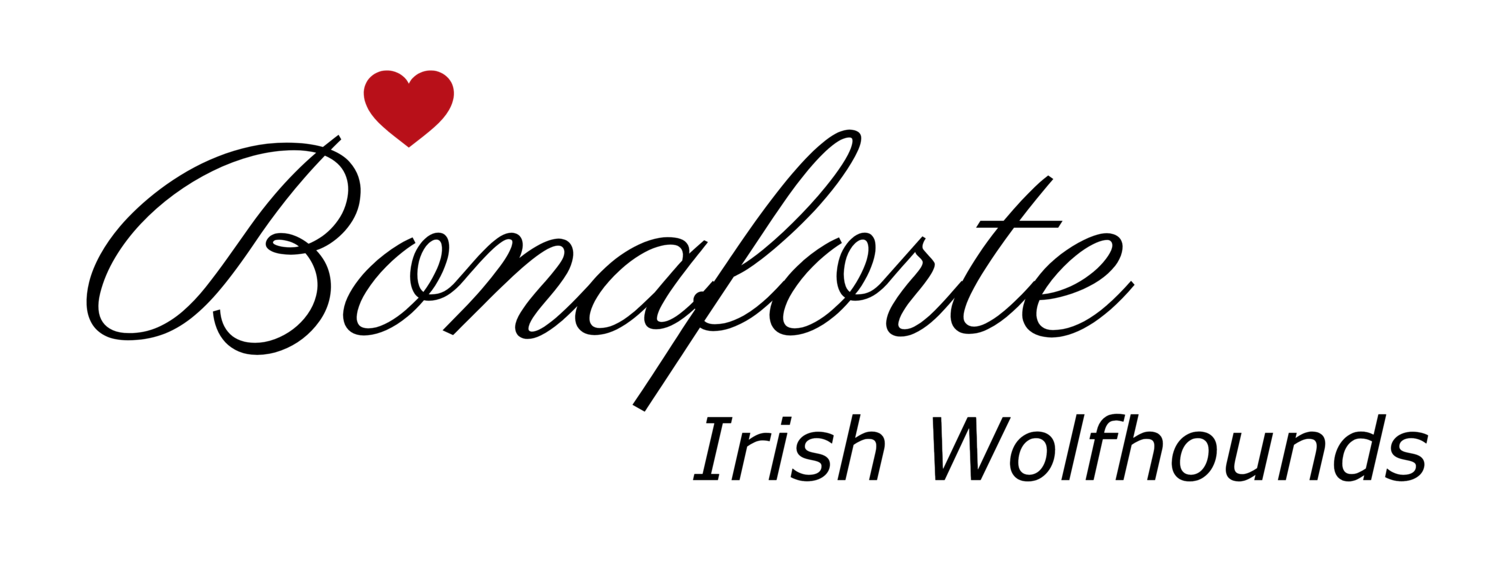EXERCISING Your Irish Wolfhound Puppy
Is More About Less!
Giant breeds take much longer to fully develop and they take a certain specialist approach to exercise. In these notes I try and explain how these pups grow; it is the approach that I am taking with the pups retained here. I would never say there is a guarantee that you won’t experience any growth problems with your puppy, giant breeds can be genetically predisposed to such things, but there is a lot you can do to prevent it happening by accident. Some of this information might appear to be overkill but if you can look back and say you did everything you could to rear the puppy carefully, that is better than looking back saying ‘I wish we hadn’t done this, or I wish we had done that…’. I have used some images to help you visualise what I mean.
Although you can’t wrap your puppy in cotton wool, exercise and general activity does need to be watched especially up to the age of 6 – 7 months, and then managed carefully up to 12 months. If accidental damage occurs it us usually in the period up to 6 months old.
Most problems in a growing giant breed like the Wolfhound stems from trauma to the growth plates that remain soft until the dog is fully grown, or damage to the cartilage between the bones in the shoulder and stifle.
What are Growth Plates? The epiphyseal plate - is a hyaline cartilage plate in the metaphysis at each end of long bones.
At the ends of the long bones- particularly in the forelegs is an area that remains soft until the hound is about 12 months old. When a young puppy continually does high impact activities i.e. jumps downwards thus putting undue stress on the growth plates, these can become damaged.
What is Cartilage? – A flexible connective tissue found in many areas in the bodies of humans and other animals, including the joints between bones.
The main conditions we are trying to avoid by being careful with exercise are:-
Osteochondritis dissecans – otherwise called OCD. This is caused by blood deprivation in the joint of the shoulder or less commonly the stifle. This loss of blood flow causes a part of the bone to die. The bone is then reabsorbed by the body, leaving the cartilage it supported prone to damage. The result is fragmentation of cartilage and bone, these fragments lie within the joint space, causing extreme pain to the dog. Usually this damage is done early on – around 15 – 16 weeks but it can happen up to 9 months. It is uncertain what the underlying cause of OCD is; whether genetic predisposition; diet or trauma, but what we are trying to do is eliminate the chance of diet and trauma causing it.
Carpal Vulgas – this is a condition, usually involving the radius and ulna in the front limbs. Deformities can occur due to damage (could be a knock or a bang) to the growth plate on one of the long bones, and cause it to close prematurely. Consequently one bone keeps growing but the other does not, and twisted forelimbs results. This is NOT TO BE CONFUSED with a normal ten to two appearance of the feet of a growing puppy. If Carpal Vulgas is apparent you will see it clearly.
You must caution against your puppy performing ‘high impact’ exercise which can be as simple as:
- Running freely or rough playing with other dogs.
- Free access to steps or stairs.
- Jumping on and off furniture/beds.
- Tearing around on a hard concrete surface.
- Walking for over long periods. You won’t be talking your puppy ‘out for a walk’ as we would generally understand that to be - before 6 months of age.
Obviously jumping up people should be discouraged anyway. But anything that puts undue stress on the growth plates needs to be avoided.
You do not need to worry about development of muscles at this age so the back garden of your property will suffice for the puppy to run free in up to 6 months old.
THIS DOES NOT MEAN HE NEVER LEAVES THE HOUSE. On the contrary, you should be spending this time putting puppy in the car and taking him to socialisation situations like getting used to car travel, going to meet the kids from school, going into town where you can sit with a coffee and let him watch the world go by, but nothing that involves long periods of exercise, just a short walk to and from your vehicle.
You must begin to lead train your puppy as soon as you get him, and take him out to socialise with people and other animals, but not to walk him very far, 5/10 minutes is enough in the street with the intention of meeting traffic and people. He must have been fully vaccinated before you do any of these things.
Up to 6 months old your garden is enough area for puppy to play in, preferably on grass and not concrete, and always supervised. We suggest that after 6 months, lead walk the puppy, 20 minutes is enough, and allow only 5 to 10 minutes free off the lead on his own, fully supervised. Build this up in the intervening months to longer periods and after 12 months your hound should be able to exercise freely. As a grown adult 1 hour per day combined lead walking and free running will keep your hound in good muscular condition. You can always call me and compare notes.
A good indication on whether your puppy is continuing to grow is to feel his knuckles on the forelegs, in a growing pup these are quite bumpy on the front of the leg, whereas in the grown hound – this flattens out.
Courtesy of Jean Timmins http://www.cornovi-iw.co.uk/Rearing.htm



